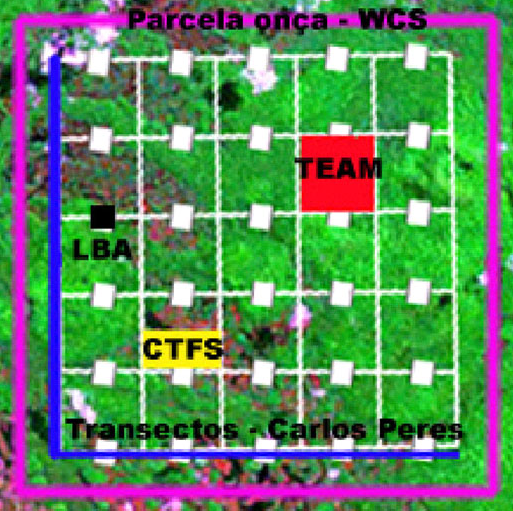Languages
Compatability with Existing Initiatives.
Several initiatives for biodiversity monitoring are in operation. For reasons already discussed, these initiatives have limitations in terms of taxonomic or geographical coverage. However, they have accumulated extremely valuable data that can be used to assess long-term trends in some groups. To maximize the usefulness of PPBio LTER sites, and modules used for bioprospecting and impact assessment, it is important that data from these initiatives can be integrated with data collected by PPBio. Making sure this was possible was one of the main considerations when designing the first PPBio grids and sample plots.
The following figure shows a grid with hypothetical PPBio modules, combined with the sampling formats used other major biodiversity or ecosystems monitoring projects.

The central 100 ha plot used for the Conservation International’s initial TEAM study sites lies within one of the 1 km x 1 km squares in the PPBio grid system (see the red square in the figure). There are two TEAM plots in the Ducke Reserve. The vegetation research is conducted in smaller sub-plots within of 100 ha plots and only large and woody plants are only inventoried in a central 1 ha plot. TEAM plots are too small for effective monitoring of most mammals. Therefore, studies with camera traps and other survey methods are conducted outside the main plot, as this suffers intense disturbance from human presence. TEAM use camera traps throughout the Ducke Reserve, using PPBio trails for access.
The Smithsonian Institution’s CTFS initiative has installed 50 ha plots throughout the world, and, though costly, these are helping to revolutionize our thinking about tropical forests dynamics. A standard CTFS plot 50 ha would cover half of a 1 km x 1 km PPBio system grid (see the yellow square in the figure). The Smithsonian plan to install a CTFS portion within the existing Reserva Ducke grid, but waiting on funding (Kyle Harms, personal communication).
The Large-Scale Biosphere-Atmosphere Experiment (LBA) in Amazon was originally a joint project between the U.S. space agency NASA, the EU and the Brazilian Ministry of Science and Technology (MCT), It is now being continued as a purely Brazilian project. It provides an example of how using high technology to study ecosystem processes can be most effective when placed in an existing program large-scale program, like PPBio. The synergy has meant that produced with high cost can be widely used by other diverse disciplines (see the black square in the figure). A new LBA / PPBio coordinated initiative plans to install PPBio grids around each LBA flux tower.
The 1 ha vegetation survey plots that are standard for conventional botanical and forestry sciences studies can be easily accommodated within the PPBio grids and, indeed, PPBio’s Ducke Reserve grid is already part of the Amazon Tree Diversity Network. The ecological research station Maracá island, in Roraima, northern Amazonia, has a system of permanent plots for studies of vegetation installed by Jose Fragoso et al. which uses the PPBio system. Heraldo Vasconcelos uses modules indetical to the PPBio permanent terrestrial study plots to sample ants in in conventional 1 ha vegetation study plots within the PDBFF study area.
Carlos Peres of the University of East Anglia (UK) and colleagues have conducted extensive surveys of the medium and large mammal assemblages throughout the Amazon. Many of these surveys were based on standard 5 km transects. The PPBio grid is designed to allow mammal surveys comparable with those that have been conducted by Peres and co-workers (see the blue lines in the figure).

